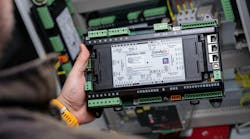Examining Google’s Sustainable Approach to Data Center Construction
Building sustainable data centers is a complex task that requires a huge number of issues to be addressed, from site selection to construction materials, to technical decisions in equipment for power and cooling, to ongoing operations.
This makes Google’s ongoing efforts to build sustainable data centers even more important, and the company's focus on accelerating clean energy adoption, cutting-edge design, community involvement, and fostering economic growth stand out even more.
Strategic Partnerships
As a global leader in technology and innovation, Google is redefining how data centers are powered and constructed by integrating clean energy solutions and advanced infrastructure planning.
Through strategic partnerships and groundbreaking initiatives, the company is working on setting new standards for sustainable development.
Most recently, Google has partnered with Intersect Power and TPG Rise Climate to create a sustainability-focused approach to synchronizing data center development with clean energy generation.
This tri-party collaboration aims to co-locate data centers and clean energy plants, ensuring that the facilities’ energy demands are met sustainably from day one.
Data center campuses will be built with energy generation on-site, which, among other things, will reduce the impact of the development of these new data centers on the grid. The first phase of this initiative is expected to be operational by 2026 and fully completed by 2027.
This strategy addresses key challenges in the U.S. energy landscape, including grid capacity constraints and prolonged project timelines.
By developing industrial parks that integrate gigawatts of data center capacity with dedicated clean energy plants, Google is reducing the need for extensive new transmission infrastructure and accelerating the deployment of renewable energy resources.
The approach not only supports the grid but also enhances its reliability, making it a blueprint for future infrastructure projects.
About this project, Jim Coulter, Executive Chairman of TPG and Managing Partner of TPG Rise Climate, said:
Bringing together a leading carbon-free power producer, one of the world’s largest hyperscalers and the leading private equity investor in climate solutions to capitalize on this opportunity, we are committed to delivering carbon-free data centers at lower cost and greater scale.
New Clean Energy Investment Models Can Provide Direction for the Industry
Earlier this year, prior to the recent partnership announcement, Google announced that it was taking a new approach to utility collaborations like the Clean Transition Tariff (CTT) in Nevada.
Developed in partnership with NV Energy, a Berkshire Hathaway subsidiary, this innovative rate structure facilitates investments in clean firm capacity technologies, such as enhanced geothermal energy.
It has the potential to head off power disagreements such as the one currently ongoing in Ohio between the data center industry and AEP. Unlike traditional power purchase agreements (PPAs), the CTT integrates directly with utility planning processes, looking to ensure a seamless transition to 24/7 carbon-free energy (CFE).
Google’s collaboration with NV Energy marks a significant step towards scaling early-stage clean energy technologies. By enabling the deployment of 115 MW of enhanced geothermal capacity through developer Fervo Energy, Google is looking to demonstrate the viability of round-the-clock renewable energy solutions.
The issues of renewables such as solar and wind being subject to vagaries of time and weather are directly addressed by the focus on geothermal. Also, this project underscores the potential of customer-driven demand to accelerate technological advancements and reduce costs for emerging clean energy solutions.
A Fortuitous Convergence
The convergence of decarbonization and digitization presents unique opportunities and challenges for the energy and technology sectors. As AI, electrification, and industrial growth drive increased electricity demand, proactive steps are necessary to meet this demand sustainably.
Economists estimate that AI alone could contribute over a trillion dollars annually to the U.S. GDP by 2030. To harness this potential, reliable and clean energy sources are critical, especially when energy sector analyst are also predicting that by 2030 the energy demands of AI could represent 25% of electricity usage in the United States.
This new “power first” approach to data center development directly addresses these challenges. By co-locating data centers with new renewable energy facilities, this type of campus development can ensure that clean energy is not only generated but also efficiently utilized.
This model minimizes grid strain and has the additional advantage of supporting economic growth in rural areas, where many of these projects are located.
Beyond Data Center Operations to Economic and Environmental Benefits
Google’s commitment to sustainability extends beyond environmental considerations to include significant economic benefits.
The company’s clean energy partnerships and investments are creating jobs, driving rural economic development, and fostering innovation in energy technology. By aligning its growth with clean energy deployment, Google is helping to build a thriving carbon-free economy.
For example, the partnership with Intersect Power and TPG Rise Climate is designed to unlock meaningful opportunities for local communities. These projects not only reduce carbon emissions but also generate long-term economic benefits by creating high-quality jobs and supporting local businesses.
Then too, one of the key obstacles to scaling clean energy and data center capacity is the inadequacy of existing grid infrastructure.
Many regional grids face generation capacity and transmission bottlenecks, leading to prolonged project timelines and increased costs. Google’s strategic approach to data center siting and power sourcing directly addresses these issues.
By integrating clean energy generation with data center development, Google is reducing the dependency on traditional grid infrastructure and shortening project delivery timelines. This integrated model is a significant evolution in the way hyperscalers and power providers collaborate, ensuring that new energy capacity is purpose-built to meet the specific needs of data centers.
A Nuanced Collaboration
Like any multi-vendor project, the success of these sustainable data center initiatives hinges on collaboration with various stakeholders, including utilities, regulators, and private investors.
The partnership with NV Energy exemplifies this collaborative approach, bringing together utilities, energy developers, and technology companies to achieve shared sustainability goals.
Similarly, Google’s engagement with Intersect Power and TPG Rise Climate highlights the importance of aligning private capital with public sector objectives.
By co-locating data centers with renewable energy plants, these partnerships demonstrate how it is possible to deliver solutions that can address both economic and environmental challenges.
Making the 'Power First' Ethos Global
Given Google’s global footprint, the “power first” approach to data center development has the potential to be implemented in markets worldwide, accelerating the transition to clean energy and reducing carbon footprints worldwide and serving as a test project to prove the feasibility of these collaborations not only in the data center world but for any energy-intensive industry development.
As an example, the CTT could potentially be adapted to various regulatory environments, enabling utilities and large energy users to collaborate on clean energy projects. This scalable framework ensures that the benefits of these latest sustainability efforts could extend far beyond its immediate operations.
Enhanced geothermal energy, long-duration energy storage, and advanced nuclear power are among the solutions that Google is exploring to provide reliable and sustainable power and to achieve its goal of operating on 24/7 carbon-free energy by 2030.
Investing in next-generation clean energy technologies is just one piece of the overall strategy for meeting these goals, not just by Google, but by the entire data center industry. By driving demand for early-stage technologies, Google is helping to bring these solutions to market faster, reducing costs and increasing their accessibility for other energy users.
The Sustainability Impetus
These efforts to build sustainable data centers reflect a broader vision for a carbon-free future. By integrating clean energy generation with digital infrastructure development, a new standard is being developed for sustainability in the technology sector.
Through strategic partnerships, innovative models like the Clean Transition Tariff, and investments in emerging technologies, Google is demonstrating that it is possible to meet growing energy demands while reducing carbon emissions.
As electrification, industrial growth, and digitalization continue to shape the global economy, these initiatives, along with other efforts being made by hyperscalers and others in the industry, provide a roadmap for balancing economic growth with environmental responsibility.
This approach to building sustainable data centers is more than an environmental commitment; it is a strategic investment in the future of energy and technology.
By synchronizing data center growth with clean energy generation, pioneering new procurement models, and fostering collaboration across sectors, Google and the data center industry need to be leading the way in creating a carbon-free economy, as indeed they are.
About the Author



